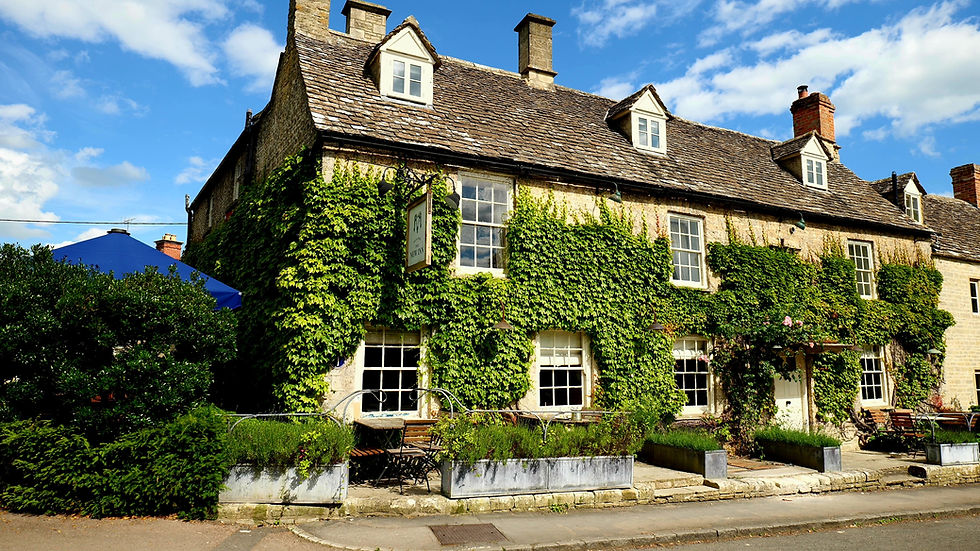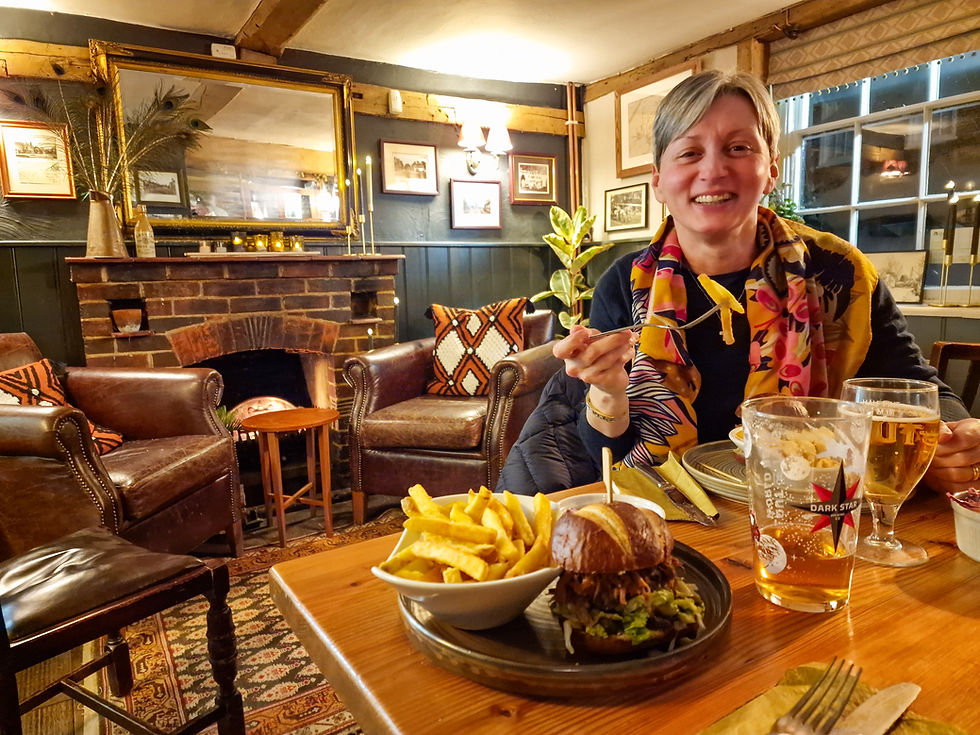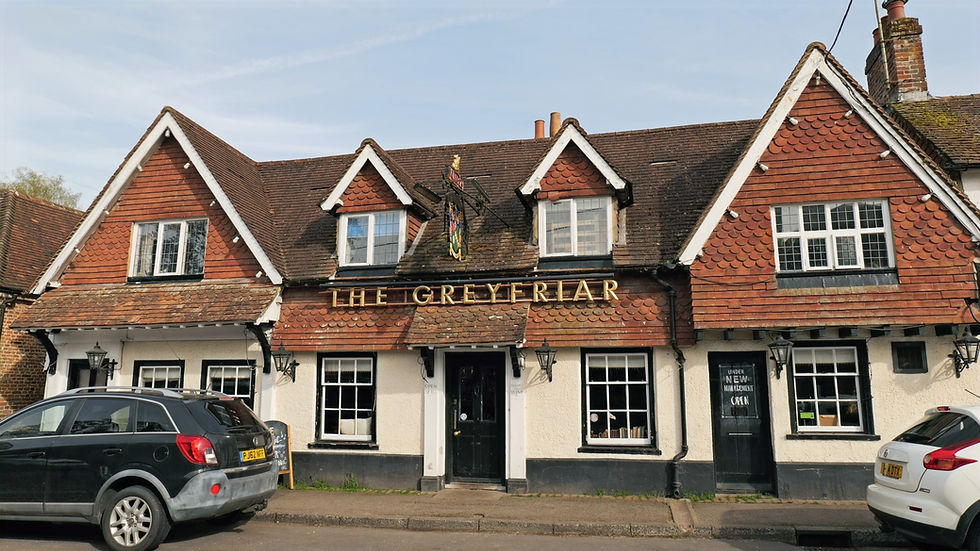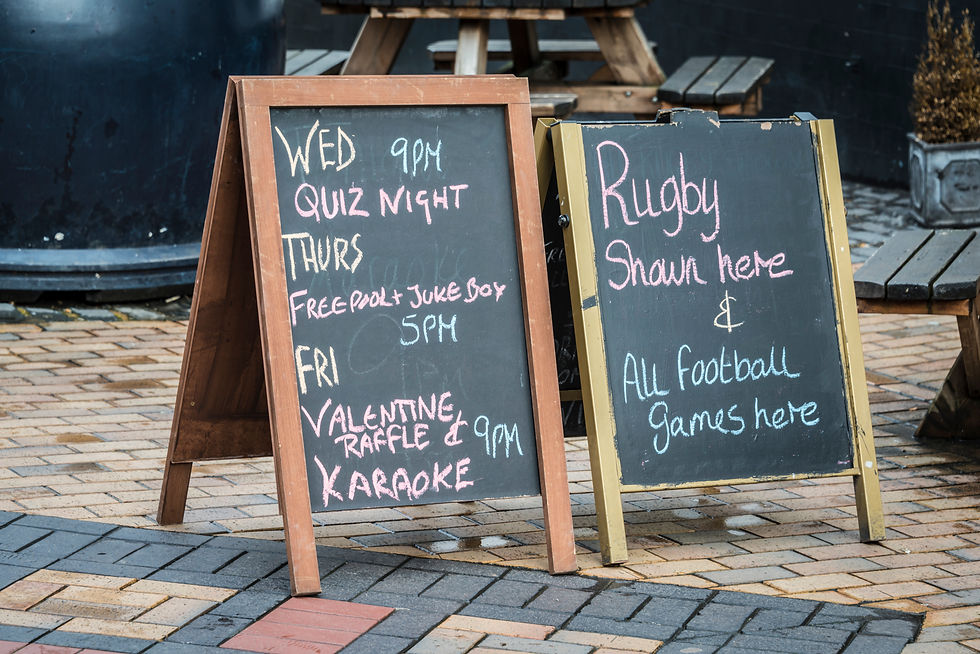His Majesty, the pub. History & fun facts about English pubs
- Laura Mattei
- Aug 1, 2024
- 11 min read
Updated: Aug 17, 2024

Pub are one of the symbols of Britain and, in particular, of the English countryside.
I don't think there is a single person in the UK who has not entered a pub at least once to drink a beer, play darts or to dine with cottage pie, bangers & mash or fish & chips, the traditional ‘pub food’. And this is also true for the millions of tourists who visit England and the other British nations from all over the world every year.
Since I moved to England, pubs are by far my favourite place to dine or meet friends and now I seldom go to eat in traditional restaurants.
Although I am aware that pubs are today very different compared to 60, 50 or even 20 years ago, I love the warm atmosphere of these cosy places steeped in history, that have quirky names and where you usually eat on thick oak tables, surrounded by curved beams, creaking floors and crackling fireplaces.
There are few other places where you feel more in England than in a country pub, with dogs roaming freely, the aroma of draught beer and the laughter of other patrons hanging in the air.

But how many people know what the word ‘pub’ means and what are the historical origins of these very British establishments?
The role of the pub in British society
The pub is a quintessentially British institution.
Its worldwide fame is mainly due to the crucial role that pubs have played in the social life of British people over the centuries - a role that has gone far beyond their commercial purpose.
The pub is, in fact, not only a place to enjoy a pint (or two...) of ale, the typical warm British beer with a rich and fruity flavour that is quite different from continental lager, or to eat Sunday Roast with Yorkshire puddings, the traditional English Sunday dish, but also a social hub, a place where people meet, discuss and cultivate relationships.
In English villages in particular, pubs are still the focal point for the community and play an important role in local life, to the point that they are usually called ‘local’ rather than by their name.

Where does the word ‘pub’ come from?
The word ‘pub’ is an abbreviation of Public House, i.e., a licensed establishment serving beer and other beverages, where it is usually possible to eat on the premises and, often, stay overnight.
A bit of history
The origin of the English pub dates back to Roman Britain.
When, in 43 A.D., the legions of Emperor Claudius invaded what was then called Britannia, in addition to building roads and forts, they also built the so-called tabernae, or taverns, i.e., places open to the public that sold wine and food, created primarily to quench the thirst of and provide a place to have fun for soldiers travelling along the roads of the empire.
In time, these taverns started to sell ale too, which was already produced by the various British tribes.
Remains of tabernae can be found all over England inside former Roman settlements. I had the opportunity to visit one in the civil settlement (Vicus) that developed around the frontier fort of Vindolanda, in the county of Northumberland, when I walked North England coast-to-coast along the route of the ancient Hadrian's Wall.
With the arrival of the Anglo Saxons at the end of Roman presence in Britain in 400s A.D., tabernae turned into alehouses.
Alehouses became increasingly popular, to the point that, in 969 A.D., King Edgar was forced to issue a decree stating that there could be no more than one alehouse per village. Edgar also introduced a unit of measurement known as ‘the peg’ to limit the maximum intake of alcohol per person – clearly, excessive alcohol consumption was already an issue in Anglo-Saxon times!
The English expression ‘to take someone down a peg or two’ seems to have originated from this decision taken more than 1,200 years ago, although the connection is not certain.
In King Edgar's times, and for many centuries thereafter, taverns and alehouses offered mainly food and alcohol, while inns, establishments usually located along the main roads, a place to sleep.
The name ‘pub’ gradually began to replace alehouse during the reign of Henry VIII, in the late 1400s.
It became increasingly popular during the reign of his son, the infamous Henry VIII and those of his three offspring and successors: Edward VI, Mary I and Elizabeth I.
1552 was an important year in the long history of pubs. That very year, in fact, during the reign of Edward VI, an act was passed that, for the first time, required owners of an alehouse or tiplinghouse (from tipling, alcoholic beverage) to have a licence to run the premises.
The law was introduced to limit violence and antisocial behaviours caused by excessive alcohol consumption. It empowered the Justices of the Peace, who administered justice at local level on behalf of the monarch, to issue licences for Public Houses and to choose the licence holder based on their ability to curb the problem of public drunkenness, which had evidently assumed alarming proportions at the time of the act.
According to a government-ordered census, in 1577 there were 17,959 premises selling alcohol in England, 86% of which were alehouses (pubs), 12% inns and 2% taverns - about 1 pub every 142 people, given the population of the time!
The advent of carriages and the increase in social mobility that came with it marked the beginning of another era for pubs.
Coach Inns were built along strategic roads to offer travellers not only food and drink, but also a safe place to sleep and change horses before continuing their journey.
Travellers in those days were of two types: those who travelled inside the carriage, and those who drove it or ensured the safety of the journey. The former were given the warmest welcome in inns and pubs and were allowed into the private dining rooms, while the latter could only sit and eat in the public bar.
All coach inns and pubs at the time, even the smallest ones, strictly reflected this rigid social distinction, and were divided into separate rooms reserved to the various social classes of travellers and patrons.
This social distinction no longer exists today - the internal partitions have been removed and everyone is welcome in the 31,000 or so pubs that exist today in England and Wales.
Pubs have over time become synonymous with the breaking down of social hierarchies that, in some respects, still persist in other areas of British society.
Subsequent laws have addressed and regulated other key aspects of pub life – from opening and closing times, to the time for the last round of beer (currently 11.30pm Monday to Thursday, 12.30am on Fridays and Saturdays, and 11pm on Sundays), Sunday closures (previously compulsory, now removed) and the minimum age for serving alcohol (18 in general, 16 if drinking is part of the consumption of a hot meal in the presence of an adult).
The pub today

Pubs have undergone a significant transformation since the end of the Second World War. A transformation that is still ongoing and whose final outcome is hard to imagine.
In a way, given its centrality in the life and psychology of the British people,
the changes in the role of the pub mirror the profound changes that have taken place in British society in the past 50 years .
For centuries, people went to pubs mainly to drink and socialise, rather than to eat.
Attendance was much more regular, in the sense that people went always to the same pub, their ‘local’, more or less at the same time - usually after 6.30 pm, immediately after supper - and stayed until closing time.
Everyone knew each other, socialised, and enjoyed sharing their free time after a day of hard work with familiar people who, in many cases, were also friends.
Pubs were mostly owned and run by locals, and were places of relaxed social gathering, as well as commercial enterprises.
Traditional pub culture reflected the community spirit that has always been (and, at least in villages, still is) a fundamental component of British society.
As a patient in the hospital where I work once told me, when he was young people went to the pub to have a pint (maybe two or three...), play darts, listen to live music and have a good discussion (sometimes even a healthy argument!) about their favourite team or the upcoming general elections, not to have dinner!
All this started to change in the 1960s and 1970s and has accelerated over the last twenty years, leading to the current situation, in which food has become predominant in almost all pubs and has pushed the traditional drinking element further and further to the margins.

There are far fewer pubs nowadays than in the past. In 1960, there were over 75,000 pubs in the UK. The number has since crashed, with a particularly rapid drop between 2005 and 2015 and, of course, following the 2020 – 2021 pandemic.
Although the concept of ‘local’ is still alive and is particularly relevant in villages and the countryside, people today tend to go to different pubs, primarily to have dinner or lunch and, in most cases, end up eating or drinking next to complete strangers – a situation that was quite unusual in the 1970s and definitely rare until the 1960s.
Many social and economic factors have contributed to this fundamental shift: the concentration of pub ownership in the hands of the large industrial breweries, which have the power to impose exorbitant prices and minimum quantities of beer to purchase to individual pub managers (the ‘publicans’); changes in social-drinking pattern, and in particular the consistent fall in the quantity of alcohol drunk on average by people in Britain; the spread of televisions in private homes, which has removed the need to go to the pub to watch the news or football or rugby matches; constantly rising rents and business rates, which often make management of pubs unaffordable and the offers by the residential construction industry much more attractive for landlords; the tightening of drink-drive legislation, the smoke ban and the increasing cost of the average pint - momentous societal changes introduced by various British governments over the past thirty years that make pubs a less attractive proposition for socialising than in the past, especially to younger people.
Whatever the reason for this change, English pubs are looking increasingly like restaurants or, especially in London, tourist traps, and less and less like the old ‘local’ of yesteryear.
Since the late 1990s, this evolution has even been given a name - gastropubs, i.e., pubs offering sophisticated menus, often offering international cuisines instead of the traditional ‘pub food’, and wine lists to rival those of starred restaurants. Indeed, pubs themselves have begun to sport stars: 21 pubs in the UK now boast a Michelin star and one, the Hand and Flowers in Marlow, a picturesque town in Buckinghamshire, even two stars!
The crucial role of country pubs
All this, however, is mostly true in cities.
In villages, country pubs continue to play a vital community role.
While they usually offer excellent food cooked by expert chefs using fresh local produce, they have retained much of the traditional charm of the old pubs, not only because of their quirky furnishings and décor.
People in villages go to the pub to meet other villagers, to chat with friends over a beer, a pint of cider or a gin and tonic in the bar or beer garden, to watch the Six Nations or the Three Lions, the English national football team, or to take part in a Quiz Night, the points-based game where various teams compete with each other by answering to questions on various topics and that in most country pubs is usually held once a week after dinner.

The bond between villages and their pubs is so deep that, in some cases, local communities have stepped in to prevent the closure of their beloved ‘local’ by directly purchasing the licence and managing it democratically.
According to the Plunkett Foundation, the charity that helps people buy and run community pubs, there were 174 community-owned pubs in England at the beginning of 2024. There are a few in Hampshire, the county where I live, and they seem to work well.
As I explain in my blog on the history of English villages, a settlement in England cannot really call itself a village without its pub so it makes sense that villagers sometimes take matters into their own hands when commercial landlords fail!
The future of pubs
It is difficult to predict how English pubs will look like in 20, 30 or 50 years. As it has always happened in the past 1000 years, their evolution will reflect that of the wider society they are constituent part of – and predicting the future of society in era of tumultuous technological and cultural change is an even more difficult challenge.
Whatever the future,
a key concept the future of pubs seems to revolve around is quality – and this is particularly true for country and village pubs.
Quality means many things when it comes to pubs: quality in food and produce, quality (and variety) in the beer offering, with craft beers and gin brewed locally becoming increasingly popular among consumers, quality and innovation in the menu in respect of tradition, quality in the ambience and décor without affecting history and character.
The growth of many small local craft breweries, which compete directly with large industrial groups in the name of authenticity and sustainability, goes precisely in this direction and offers a glimpse of how pubs can continue to retain their central role in a rapidly changing society.
Trivia
According to Historic England, the public body that manages England's historic heritage, the oldest surviving purpose-built pub in England is The George Inn in Norton St Philip, Somerset, whose original structure dates back to the late 1300s. Other pubs sport even older building dates - some of them even claim to date back to the Anglo-Saxon period! - but in almost all cases the evidence provided to support these claims is either unverified or patently unreliable, so I prefer not to mention them.
The highest pub in Britain is the Tan Hill Inn, which stands at 528m in the beautiful Yorkshire Dales National Park. It's not particularly high, but England notoriously boasts beautiful rolling hills but no real mountains. If you are passing that way, I highly recommend it. It is a historic pub dating back to the 17th century, known for its warm atmosphere, traditional food and good music.
The smallest pub in England is The Nutshell in Bury St Edmunds, Suffolk: with a bar measuring just 15ft by 7ft and the walls and ceilings covered in historical photos, currency notes and military items, there's lots to look and chat about whilst enjoying a drink with (few...) friends!
Pubs have notoriously extravagant names (Hare & Hounds, Rose & Crown, The King's Head etc.) and beautiful coloured wooden signs showcasing images of the name. This is due to a law introduced in 1377, which required alehouses and taverns to display their name so that royal tax collectors could easily identify them. Since then the majority of people was illiterate, landlords decided to use images of animals, royal symbols or crests of famous lords that could be easily understood by anyone even if they could neither read nor write.
The most common name for pubs in England is Red Lion. The name is linked to John of Gaunt, the third son of King Edward III, whose heraldic crest sported a red lion. In the mid-1400s, many chose this symbol to show their support for this important royal prince, who was the indirect progenitor of the Tudors through one of his (many) illegitimate sons.
Finally, for ghost enthusiasts, one of the most ‘haunted’ pubs in England is The Ancient Ram Inn, in Wotton-under-Edge, a village near Tetbury in the Gloucestershire Cotswolds. According to the owner, Caroline Humphries, a series of unexplained phenomena occur regularly in this old building, which is over 800 years old: furniture moves on its own, doors and windows suddenly open without anyone being in the room. The pub is famous for this and, needless to say, is often sold out, with people booking overnight stays from all over the world in the hope of meeting the ghosts responsible for these strange events.
Do you like English pubs? Have you ever visited or dined in one? And, if so, what is it that you like the most of these quintessential British institutions? Let me know in the comments!
In the meantime, thank you very much for reading my blog and...cheers!






Comments